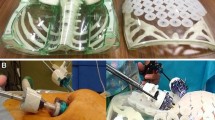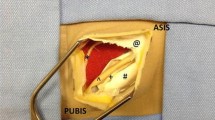Abstract
Introduction
The pre-operative three-dimensional (3D) imaging technique has resulted in a better surgical outcome for patients and has been used as an education and diagnostic tool. However, there are no reports concerning the usefulness of the 3D imaging technique in laparoscopic transabdominal pre-peritoneal repair (TAPP) so the aim of this study was to investigate the usefulness of the 3D imaging technique in laparoscopic TAPP as an educational tool for medical students.
Patients and methods
Six (6) patients who underwent laparoscopic TAPP for inguinal hernia were enrolled in this study. 3D reconstruction was performed from pre-operative computed tomography (CT) and the usefulness of pre-operative 3D simulation compared with intra-operative laparoscopic imaging was validated. Moreover, thirty (30) medical students at the university completed a multiple-choice questionnaire (MCQ) to determine the level of their satisfaction and understanding of anatomy resulting from the study.
Result
The local anatomy of the patients was identified as the same during the operation as the pre-operative 3D simulation. The results of the MCQ showed that most of the medical students were extremely (23%) or very (67%) satisfied with the effect of pre-operative 3D simulation on the quality of the surgery. Moreover, most students could understand the surgery anatomy by the 3D simulation extremely well (40%) or very well (47%) and agreed on the usefulness of this procedure for learning anatomy.
Conclusions
Pre-operative 3D simulation increases the understanding of detailed anatomy and virtual three-dimensional image analysis in laparoscopic TAPP is useful as an educational tool for medical students.


Similar content being viewed by others
References
Japanese Society for Endoscopic Surgery (2016) Thirteenth nationwide survey of endoscopic surgery in Japan. J Jpn Soc Endosc Surg 21:655–810
Yamanaka J, Okada T, Saito S, Kondo Y, Yoshida Y, Suzumura K, Hirano T, Iimuro Y, Fujimoto J (2009) Minimally invasive laparoscopic liver resection: 3D MDCT simulation for preoperative planning. J Hepatobiliary Pancreat Surg 16:808–815
Kawai M, Tani M, Ina S, Hirono S, Nishioka R, Miyazawa M, Uchiyama K, Shimamoto T, Yamaue H (2008) CLIP method (preoperative CT image-assessed ligation of inferior pancreaticoduodenal artery) reduces intraoperative bleeding during pancreaticoduodenectomy. World J Surg 32:82–87
Natsume T, Shuto K, Yanagawa N, Akai T, Kawahira H, Hayashi H, Matsubara H (2011) The classification of anatomic variations in the perigastric vessels by dual-phase CT to reduce intraoperative bleeding during laparoscopic gastrectomy. Surg Endosc 25:1420–1424
Iino I, Sakaguchi T, Kikuchi H, Miyazaki S, Fujita T, Hiramatsu Y, Ohta M, Kamiya K, Ushio T, Takehara Y, Konno H (2013) Usefulness of three-dimensional angiographic analysis of perigastric vessels before laparoscopic gastrectomy. Gastric Cancer 16:355–361
Hanaoka J, Shimada M, Uchiyama H, Ikegami T, Imura S, Morine Y, Kanemura H (2009) A simple formula to calculate the liver drainage volume of the accessory right hepatic vein using its diameter alone. Surgery 146:264–268
Enkhbold Ch, Shimada M, Utsunomiya T, Ishibashi H, Yamada S, Kanamoto M, Arakawa Y, Ikemoto Z, Morine E, Imura S (2013) One-stop shop for 3-dimensional anatomy of hepatic vasculature and bile duct with special reference to biliary image reconstruction. Hepatogastroenterology 60:1861–1864
Yao WC, Regone RM, Huyhn N, Butler EB, Takashima M (2014) Three-dimensional sinus imaging as an adjunct to two-dimensional imaging to accelerate education and improve spatial orientation. Laryngoscope 124:596–601
Davis CR, Bates AS, Ellis H, Roberts AM (2014) Human anatomy: let the students tell us how to teach. Anat Sci Educ 4:262–272
Cramer J, Quigley E, Hutchins T, Shah L (2017) Educational material for 3D visualization of spine procedures: methods for creation and dissemination. J Digit Imaging 3:296–300
Garcia J, Yang Z, Mongrain R, Leask RL, Lachapelle K (2018) 3D printing materials and their use in medical education: a review of current technology and trends for the future. BMJ Simul Technol Enhanc Learn 1:27–40
Luursema JM, Vorstenbosch M, Kooloos J (2017) Stereopsis, visuospatial ability, and virtual reality in anatomy learning. Anat Res Int. https://doi.org/10.1155/2017/1493135
Agbetoba A, Luong A, Siow JK, Senior B, Callejas C, Szczygielski K, Citardi MJ (2017) Educational utility of advanced 3-dimensional virtual imaging in evaluating the anatomical configuration of the frontal recess. Int Forum Allergy Rhinol 7:143–148
Moldovanu R, Pavy G (2014) Laparoscopic transabdominal pre-peritoneal (TAPP) procedure—step-by-step tips and tricks. Chirurgia 3:407–415
Moglia A, Ferrari V, Morelli L, Melfi F, Ferrari M, Mosca F, Cuschieri A (2014) Distribution of innate ability for surgery amongst medical students assessed by an advanced virtual reality surgical simulator. Surg Endosc 28:1830–1837
Izard SG, Juanes Méndez JA, Palomera PR (2017) Virtual reality educational tool for human anatomy. J Med Syst 41:76
Yiannakopoulou E, Nikiteas N, Perrea D, Tsigris C (2015) Virtual reality simulators and training in laparoscopic surgery. Int J Surg 13:60–64
Isaacs SJ, Goyal P (2009) Comparison between three-dimensional and triplanar computed tomography imaging of the frontal recess. Am J Rhinol Allergy 23:502–505
Nomura T, Mamada Y, Nakamura Y, Matsutani T, Hagiwara N, Fujita I, Mizuguchi Y, Fujikura T, Miyashita M, Uchida E (2013) Laparoscopic skill improvement after virtual reality simulator training in medical students as assessed by augmented reality simulator. Asian J Endosc Surg 195:501–511
Author contributions
MN and MS contributed to study concepts. YW, MN, and TT contributed to study design. MN and JH contributed to data acquisition. YW, MN, and KY contributed to manuscript preparation. YW, MN, and CT contributed to manuscript editing. MN and HK contributed to manuscript review.
Author information
Authors and Affiliations
Corresponding author
Ethics declarations
Disclosures
Yuma Wada, Masaaki Nishi, Kozo Yoshikawa, Jun Higashijima, Tomohiko Miyatani, Takuya Tokunaga, Chie Takasu, Hideya Kashihara, Daichi Ishikawa, Toshiaki Yoshimoto, and Mistuo Shimada have no conflicts of interest or financial ties to disclose.
Ethical statement and consent
All procedures followed were in accordance with the Helsinki Declaration of 1964 and later versions. Ethics Committees’ approval is not needed for this study.
Additional information
Publisher's Note
Springer Nature remains neutral with regard to jurisdictional claims in published maps and institutional affiliations.
Rights and permissions
About this article
Cite this article
Wada, Y., Nishi, M., Yoshikawa, K. et al. Usefulness of virtual three-dimensional image analysis in inguinal hernia as an educational tool. Surg Endosc 34, 1923–1928 (2020). https://doi.org/10.1007/s00464-019-06964-y
Received:
Accepted:
Published:
Issue Date:
DOI: https://doi.org/10.1007/s00464-019-06964-y




